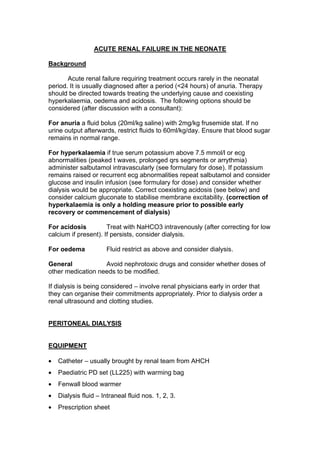
Acute renal failure
- 1. ACUTE RENAL FAILURE IN THE NEONATE Background Acute renal failure requiring treatment occurs rarely in the neonatal period. It is usually diagnosed after a period (<24 hours) of anuria. Therapy should be directed towards treating the underlying cause and coexisting hyperkalaemia, oedema and acidosis. The following options should be considered (after discussion with a consultant): For anuria a fluid bolus (20ml/kg saline) with 2mg/kg frusemide stat. If no urine output afterwards, restrict fluids to 60ml/kg/day. Ensure that blood sugar remains in normal range. For hyperkalaemia if true serum potassium above 7.5 mmol/l or ecg abnormalities (peaked t waves, prolonged qrs segments or arrythmia) administer salbutamol intravascularly (see formulary for dose). If potassium remains raised or recurrent ecg abnormalities repeat salbutamol and consider glucose and insulin infusion (see formulary for dose) and consider whether dialysis would be appropriate. Correct coexisting acidosis (see below) and consider calcium gluconate to stabilise membrane excitability. (correction of hyperkalaemia is only a holding measure prior to possible early recovery or commencement of dialysis) For acidosis Treat with NaHCO3 intravenously (after correcting for low calcium if present). If persists, consider dialysis. For oedema Fluid restrict as above and consider dialysis. General Avoid nephrotoxic drugs and consider whether doses of other medication needs to be modified. If dialysis is being considered – involve renal physicians early in order that they can organise their commitments appropriately. Prior to dialysis order a renal ultrasound and clotting studies. PERITONEAL DIALYSIS EQUIPMENT • Catheter – usually brought by renal team from AHCH • Paediatric PD set (LL225) with warming bag • Fenwall blood warmer • Dialysis fluid – Intraneal fluid nos. 1, 2, 3. • Prescription sheet
- 2. • PD fluid balance chart • Dressing pack and trolley PROCEDURE Parents should be spoken to by one of the neonatal or renal consultants prior to commencing dialysis. The PD set comes together in one pack. The bags of fluid (kept in pharmacy room) are attached to the PD set; the renal team from Alder Hey will insert the catheter, attach the set and commence the first cycle. This procedure is a sterile procedure. The dialysis fluids should be prescribed on a separate white/blue fluid prescription sheet – not on the same one as any IV fluids. If possible, when PD starts care should be provided by a nurse with no other responsibilities for that shift. Before the doctor leaves ensure that the number and length of cycles that they want the infant to initially have is clearly documented. Any future changes should be made by the renal team, this may be via telephone, and documented on the prescription chart. Completion of cycle Example of prescription might be: 1 cycle of 20mls of fluid 1, followed by two cycles of 20mls of fluid 2 – 30 minute cycles – 15 minutes dwelling time. (Refer to diagram of PD set) • 10:00 Open clamp A on solution 1 and run 20mls into the burette. • Close clamp and check clamp C is closed • Open clamp B and allow fluid to run out of the burette, through the warmer into the baby. • Leave for 15 minutes (dwelling time) • Open clamp C and allow fluid to run out of baby into the accurate measuring container. • Close clamp C. • 10:25 Measure the amount of fluid in the container, document in the “out” column and turn clamp D down to allow fluid to run into the 24 hr bag. • 10:30 Repeat procedure with fluid 2 and continue cycles following prescription. Observations and investigations Infants receiving PD should have continuous monitoring of heart rate, oxygen saturation and if possible blood pressure. If there is no invasive BP available a manual BP reading should be taken at least every 2 hrs. The infant should be weighed at least daily. The skin around the catheter site should be checked regularly and kept clean and dry. If there is any leakage the gauze swabs around the site should be weighed to assess amount of loss.
- 3. Regular blood gases and U&E’s should be carried out. Send PD sample daily for microscopy and culture. Documentation An accurate fluid balance is essential for any infant on PD. The PD fluid balance chart should be accurately completed with an hourly fluid balance that is totalled at midnight. Any leakage from around the catheter should be included in the total output. Any advice given over the phone by the renal team should be recorded in the infant notes by the person who received the information. COMMUNICATION Daily update to the renal physician involved at Alder Hey. Contact PD sister or renal nurse practitioner regarding procedure following any possible contamination of the PD circuit. References Andreoli SP Acute renal failure in the newborn. Semin Perinatol. 2004;28(2):112-23 Haycock GB. Management of acute and chronic renal failure in the newborn Semin Neonatol. 2003;8(4):325-34 This guideline is a working guideline pending discussion with the manufacturers about new peritoneal dialysis equipment 22nd December 2009 (version 2-NICU54)
- 4. Fluid bags A Burette B Warmer To baby C From baby Accurate measure 24 Hr bag D E